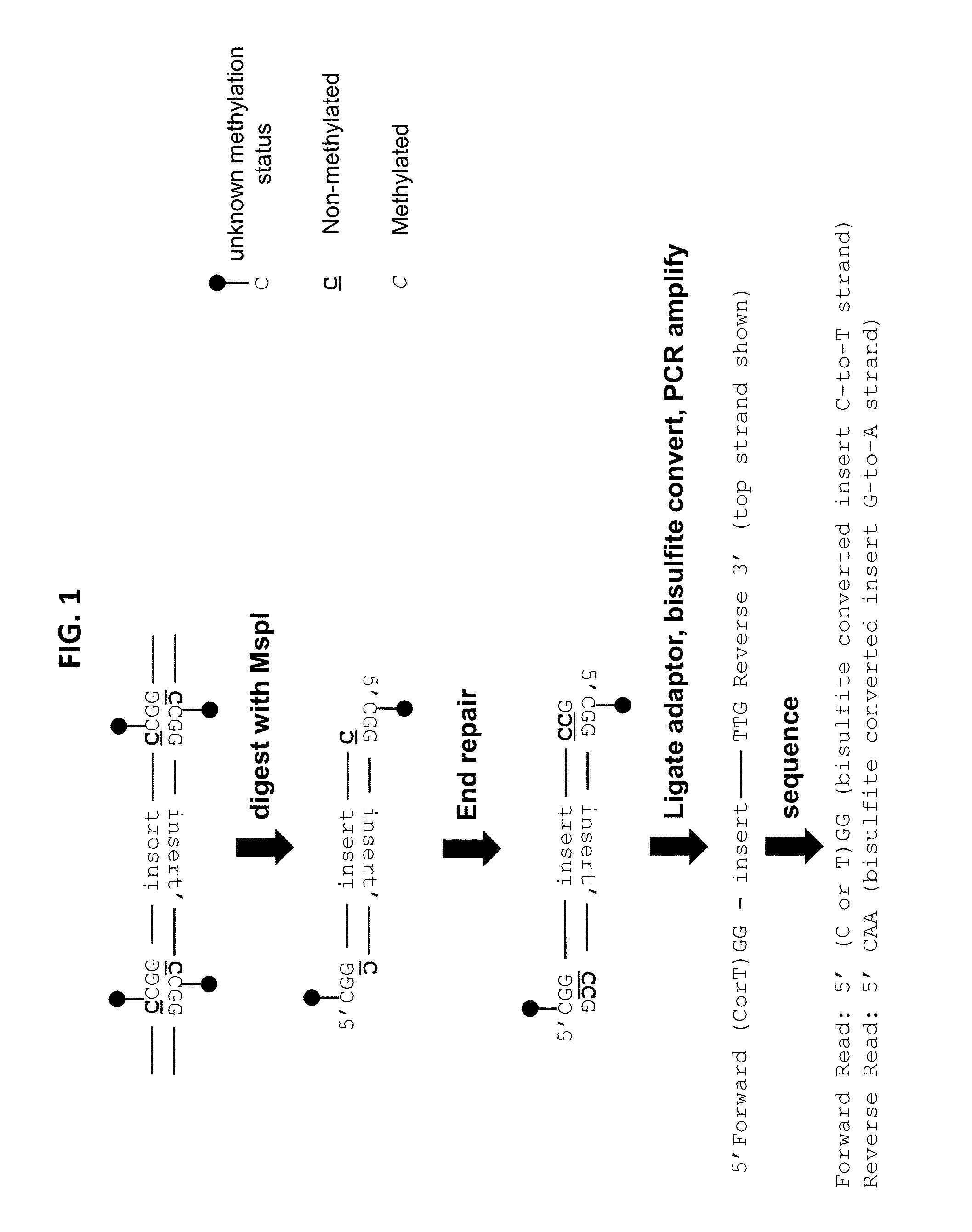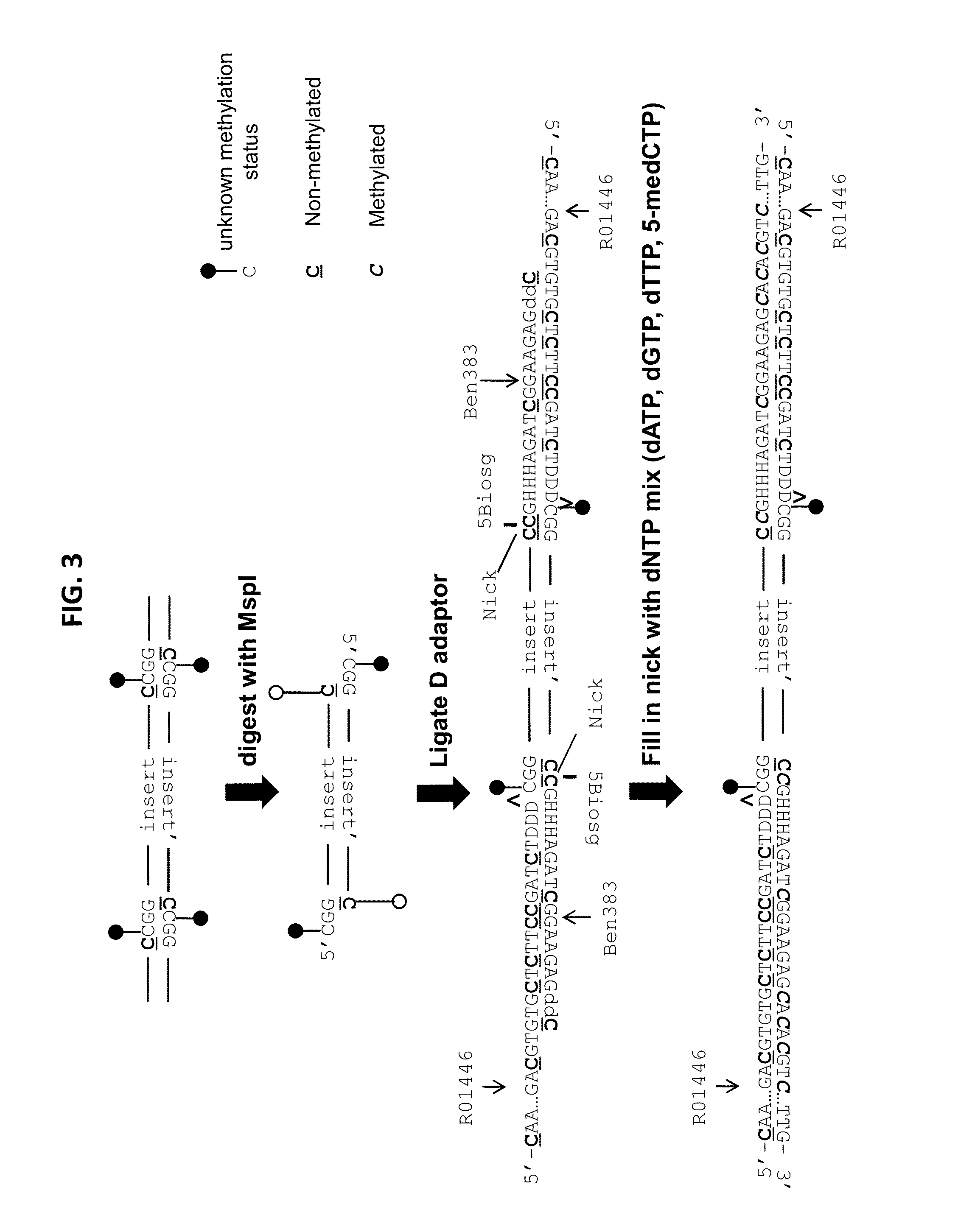Reduced representation bisulfite sequencing with diversity adaptors
- Summary
- Abstract
- Description
- Claims
- Application Information
AI Technical Summary
Benefits of technology
Problems solved by technology
Method used
Image
Examples
example 1
Generation of a RRBS Library Using Diversity Adapters
[0190]In this example, an RRBS library was generated using the diversity adapters shown in FIG. 2A-B and the sequencing results were subsequently analyzed. As shown in FIG. 2A-B, the diversity adapters can be partial duplex adapters comprising a long strand (e.g., R01446 in FIG. 2A), hybridized with a short strand (e.g., Ben383, 384, 385, or 381 in FIG. 2A) in such a manner that both ends of the partial duplex comprise a 5′ overhang. The 5′ overhang comprising sequence from the short strand of the partial duplex comprises a 5′ terminal GC sequence with a Biosg label on the terminal cytosine residue, while the 3′ terminus comprises a terminal 3′ dideoxy cytosine residue. As can be seen in FIG. 2A-B, the 5′ overhang comprising short strand sequence contains either no (D0, e.g., Ben341 in FIG. 2A), 1 (D1, e.g., Ben385 in FIG. 2A), 2 (D2, e.g., Ben384 in FIG. 2A), or 3 ((D3, e.g., Ben383 in FIG. 2A) “H” bases. The “H” bases can be eit...
example 2
Sequencing of RRBS Library Generated Using Diversity Adapters without Phi X Control
[0191]In this example, RRBS libraries were generated using diversity adapters as described in Example 1; however, sequencing of the RRBS libraries generated using diversity adapters with a 40 nucleotide forward read, 6 nucleotide index read, and 25 nucleotide reverse read was conducted without running a dedicated control high diversity Phi X control lane. As can be seen in FIGS. 10-12, the RRBS library sequenced without a PhiX control showed a Q-score distribution whereby >95% of the Q-scores were >30 (FIG. 10), an anticipated distribution of bases (FIGS. 10 and 11) whereby a diversity of bases existed at the start of the sequencing read while roughly equal numbers of “A” and “G” bases were reported further into the read, and the percentage of >Q20 scores being above 95% at PCR amplification cycles of less than 40 (FIG. 12), which indicated a low probability of an incorrect base calling. FIG. 13 shows...
example 3
Comparison of the CpGs Analyzed by Sequencing a RRBS Library Generated Using Diversity Adapters Vs. Whole Genome Bisulfite Sequencing (WGBS)
[0193]In this example, a comparison of the CpGs analyzed by sequencing a RRBS library generated by the methods provided herein vs. WGBS was conducted. The RRBS library was generated from MspI fragmented genomic DNA (gDNA) from IMR90 human cell line was ligated to a mixture of D0-D3 diversity adapters as described in Example 1 using either 400, 100, 25, 6.25, or 1.56 ng of gDNA as input for generation of the RRBS library. The library used for WGBS was generated by first subjecting 50 ng of human gDNA to Covaris sonication to an average size of 200 bp, and then generating a library for WGBS using the fragmented gDNA as input into the NuGEN Ovation® Ultralow Methyl-Seq Library System, wherein the library for WGBS was generated as directed by the manufacturer. The RRBS and WGBS libraries were each separately sequenced on an Illumina GAIIx sequencer ...
PUM
| Property | Measurement | Unit |
|---|---|---|
| Electrical resistance | aaaaa | aaaaa |
Abstract
Description
Claims
Application Information
 Login to View More
Login to View More - R&D
- Intellectual Property
- Life Sciences
- Materials
- Tech Scout
- Unparalleled Data Quality
- Higher Quality Content
- 60% Fewer Hallucinations
Browse by: Latest US Patents, China's latest patents, Technical Efficacy Thesaurus, Application Domain, Technology Topic, Popular Technical Reports.
© 2025 PatSnap. All rights reserved.Legal|Privacy policy|Modern Slavery Act Transparency Statement|Sitemap|About US| Contact US: help@patsnap.com



